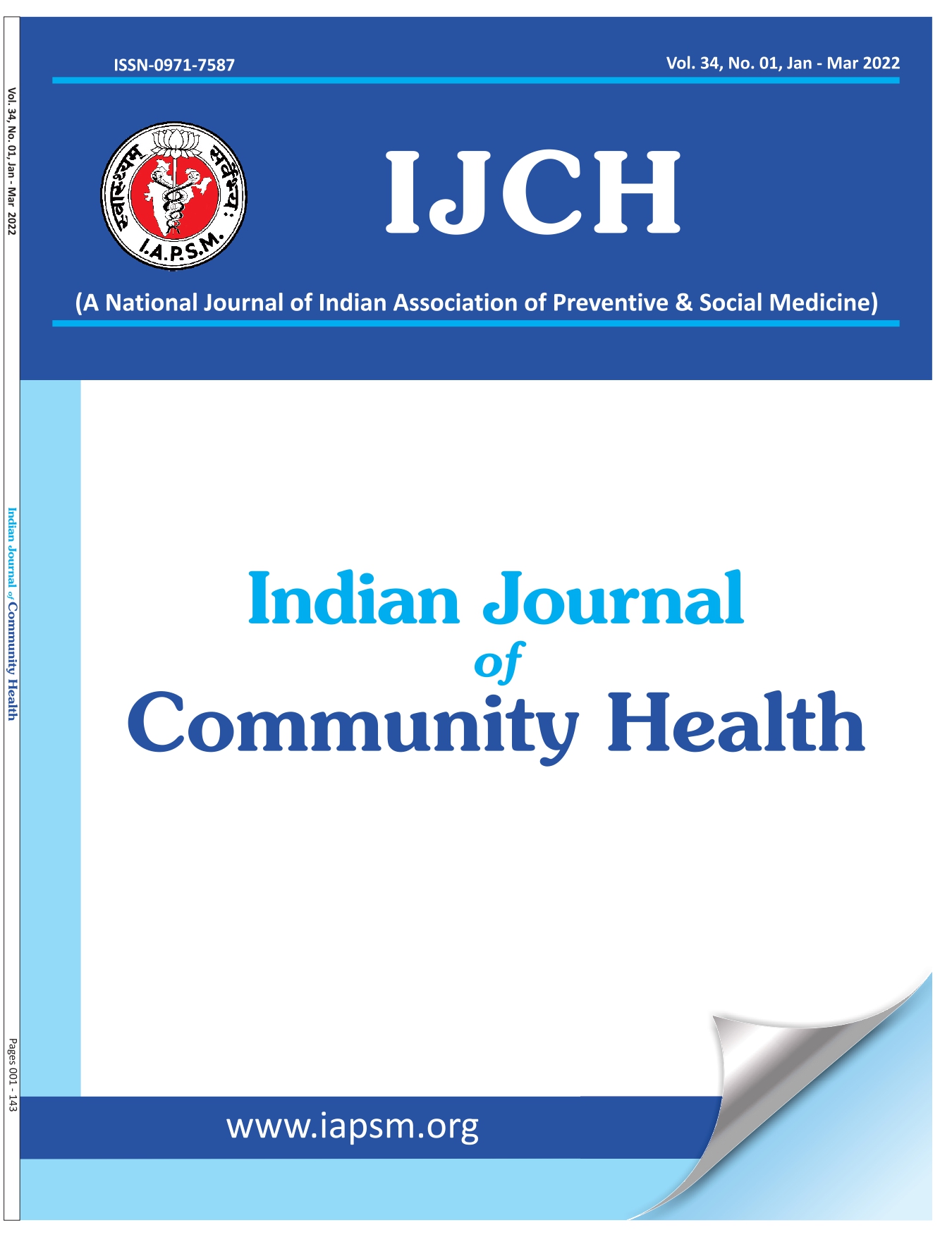Self-medication and its associated factors in Amdanga block of West Bengal
DOI:
https://doi.org/10.47203/IJCH.2022.v34i04.008Keywords:
Self-Medication, Side effects, Rural, West BengalAbstract
Background: The WHO defines the use of medications without prior medical consultation regarding indication, dosage and duration of treatment as self-medication. The practice is a global problem. Aims and Objectives: The study was conducted to describe the care seeking behavior of rural self-medicators living in Amdanga Block of West Bengal and to assess the belief in medicines by the self-medicators. Material & Methods: A descriptive cross-sectional study was conducted by interviewing with a pretested semi-structured questionnaire on 665 self-medicators out of 1740 adults who were interviewed in 80 villages of Amdanga Block, West Bengal. A three-stage sampling method was used to reach the study population. A three month recall on self-medication practice was considered operationalizing the “pull” and “push” factors of self-medicators using a Pshycho-social framework. The variables were Socio-demographic factors, Care Seeking Behaviors, Health System related factors, Belief in Medicines according to the framework. Results: The prevalence of self-medication was found to be 38.2%. 63% of the study subjects were female and 56.3% had a literacy status of middle school and above. 54.4% relied on their old prescription for self-medication. 68.7% had an initial choice to consult a doctor but later self-medicated of whom 53.2% changed their choice due to monetary and transport issues while 38.5% thought of self-medication considering their disease was mild in nature. Conclusion: Awareness and health education can link rural subjects with primary care facility and right decisions on care can be provided.
Downloads
References
A World Health Organization resource: the role of pharmacist in self- care and self-medication(1998; 17 pages) http://apps.who.int/medicinedocs/pdf/whozip32e/whozip32e.pdf ( accessed on 14/12/2022)
WHO resource Self-medication (SM) Sudan Journal of Rational Use of Medicine 2014 Jan; 1 (6):4
Marak A, Borah M, Bhattacharyya H, Talukdar K ,”A cross-sectional study on self-medication practices among the rural population of Meghalaya “ I.J.M.Sc & P.H 2016; 5 (6): 1134-1138
A World Health Organization resource Guidelines for the Regulatory Assessment of Medicinal Products for Use in Self-Medication. 2000; http://apps.who.int/medicinedocs/pdf/s2218e/ s2218e.pdf (accessed on 14/12/2022)
Ahmad A, Patel I, Mohanta GP, and Balkrishnan R. Evaluation of Self Medication Practices in Rural Area of Town Sahaswan at Northern India. Ann Med Health Sci Res. 2014; 4 Suppl 2: S73–S78. doi: [10.4103/2141-9248.138012]
Annadurai K, Selvasri S, Ramasamy J. Self Medication: Predictors and Practices among Rural Population of Nellikuppam Village, Kancheepuram District, Tamil Nadu. J of Krishna Inst of M Sci University 2017;6(1) 90-981`
Kumar CA et al. Assessment of self-medication patterns in a rural area of south India: a questionnaire based study. Int J Community Med Public Health. 2018;5(1):354-60.
Gayathri S, Kokila Selvaraj, Satyajith P, Mithunkumar G.H. Estimation of self - medication practices among rural Kanchipuram, India. IAIM, 2017; 4(10): 87-92.
Yogendra K, Radha Y, Shraddha B, Agrawal , Chavan R, Mahendrakar P: Self medication pattern in rural areas in Pune, India IJMEDPH 2012;2(4):7-11.
Noone J & Blanchette CM.The value of self medication: summary of existing evidence. J Med Eco, 2018;21:2, 201-211, DOI:10.1080/13696998.2017.1390473
Dnyanesh L, Vaidehi L, Gerard K, Gerhard F. A Systematic Review of the Literature to Assess Self Medication Practices. Ann Med Health Sci Res. 2017; 1(7): 1-14
Anderson, Jeanne & Pyle, Maurine. (2020). Force Field Analysis. 10.4324/9781003009962-19.
Limaye D, Limaye V, Fortwengel G, Krause G. Self-medication practices in urban and rural areas of western India: A cross sectional study. Int J Community Med Public Health. 2018;5:2672–85. [Google Scholar]
Hachey R, Jumoorty J, Mercier C. Methodology for validating the translation of test measurements applied to occupational therapy, Occup Ther Int, 1995; 2:190-203
Rangari GM, Bhaisare RG, Korukonda V, Chaitanya YL, N H. Prevalence of self-medication in rural area of Andhra Pradesh. J Family Med Prim Care. 2020 Jun 30;9(6):2891-2898. doi: 10.4103/jfmpc.jfmpc_204_20. PMID: 32984145; PMCID: PMC7491850.
Nair MG, Rajmohanan TP, Kumaran J. Self medication practices of reproductive age group women in Thiruvananthapuram District, South India: A questionnaire-Based study. J Pharm Sci Res. 2013;5:220–5.
Garla BK ,Karuppaiah M. Prevalence of Self-medication Practice among People Attending Oral Health Outreach Programmes in Madurai East, Tamil Nadu. J Adv Oral Res. 2017; 8(1&2) 14–20.
Kazaura MR :Levels and correlates of Self Medication among adults in rural settings of mainland Tanzania. Indian J Pharm Sci 2017;79(3):451-457
Shamsudeen SM, Priya R S, Sujatha G, Muruganandhan J, Manikandan K. Self-medication with antibiotics: A knowledge, attitude, and practice appraisal of 610 dental patients in Chennai, India, from 2016 to 2017. J Edu Health Promot. 2018;7:66. Available from: https://www.jehp.net/text.asp?2018/7/1/66/231773
Downloads
Published
How to Cite
License
Copyright (c) 2022 Suchetana Bhattacharyya, sayeli mitra, Swagatendra Narayan Basu, Inba Raja Alegasan, Rivu Basu

This work is licensed under a Creative Commons Attribution-NonCommercial-NoDerivatives 4.0 International License.





